
A graduate in podiatry medicine from the Université du Québec à Trois-Rivières (UQTR), Dr. Lounes Laoudi, podiatrist, founded the Clinique podiatrique du Sud-Ouest in 2015. Since then, he has been offering many Montrealers the benefits of his expertise in foot biomechanics, biopsy, sports medicine, paediatric podiatry and foot trauma.
He is seconded by podiatrist Aissam Jerraf, who brings his great versatility to the team and can treat all types of pathologies. Dr. Jerraf, also a podiatrist, shares his expertise with two other Montreal podiatry clinics.
Podiatrist Ron Terry Bustillo rounds out this trio with his background in podiatry medicine and kinesiology. Passionate about sports, Dr. Bustillo, Podiatrist uses his specialities to provide effective treatment for his patients’ sports injuries.
Sud-Ouest podiatry clinic
4475 Av Bannantyne #202, Verdun, QC H4G 1E2
1-438 792-0065 Toll free
Tuesday : 10:00 - 19:00
Wednesday : 10:00 - 19:00
Thursday : 10:00 - 19:00
Friday : 10:00 - 17:00
A humane and educational clinic
Located in Verdun, a few minutes from the Verdun metro station, the Clinique podiatrique du Sud-Ouest knows how to be a welcoming place. Its team of professionals welcomes you in a pleasant and friendly setting, placing priority on your well-being.
Led by the expertise of podiatrist and owner Lounes Laoudi, the team at the Clinique podiatrique du Sud-Ouest is committed to educating its patients properly. Take advantage of the best approach to get you back on your feet!
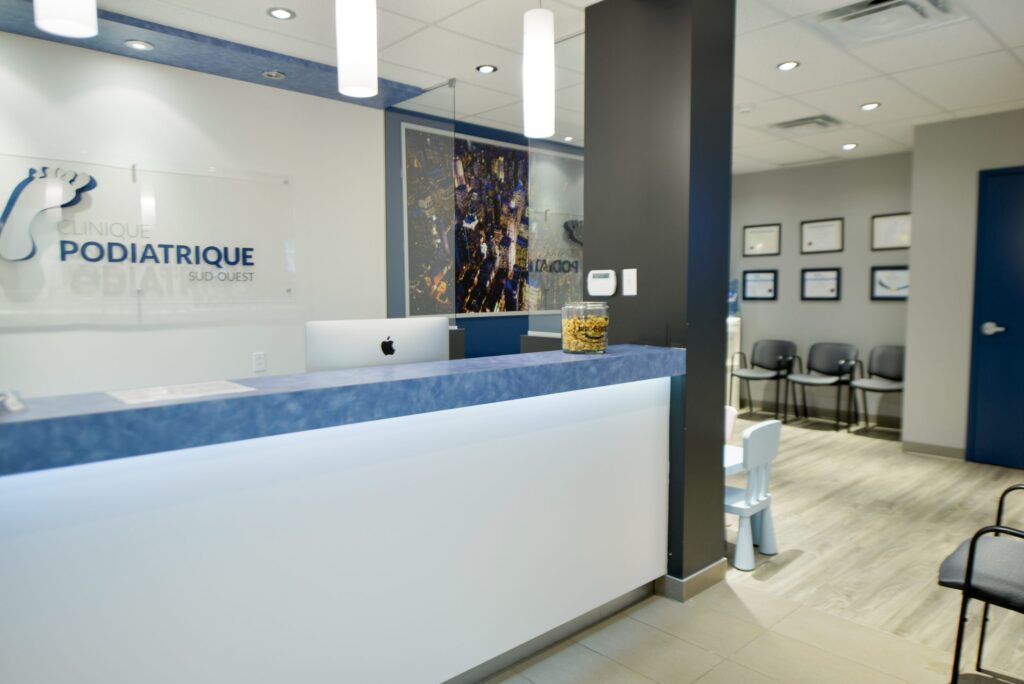
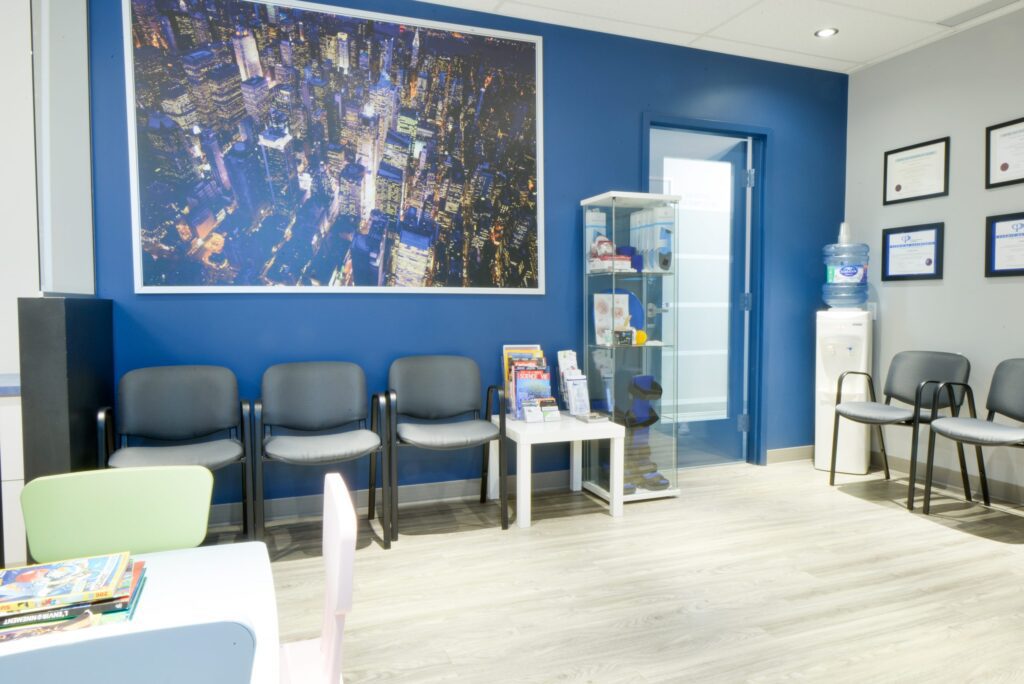
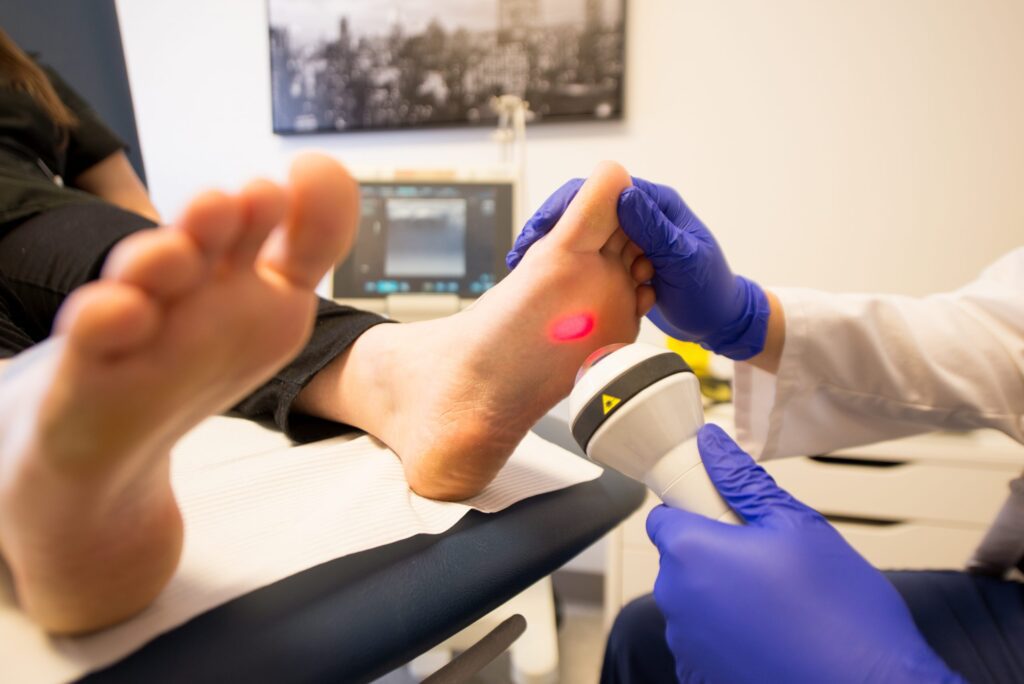
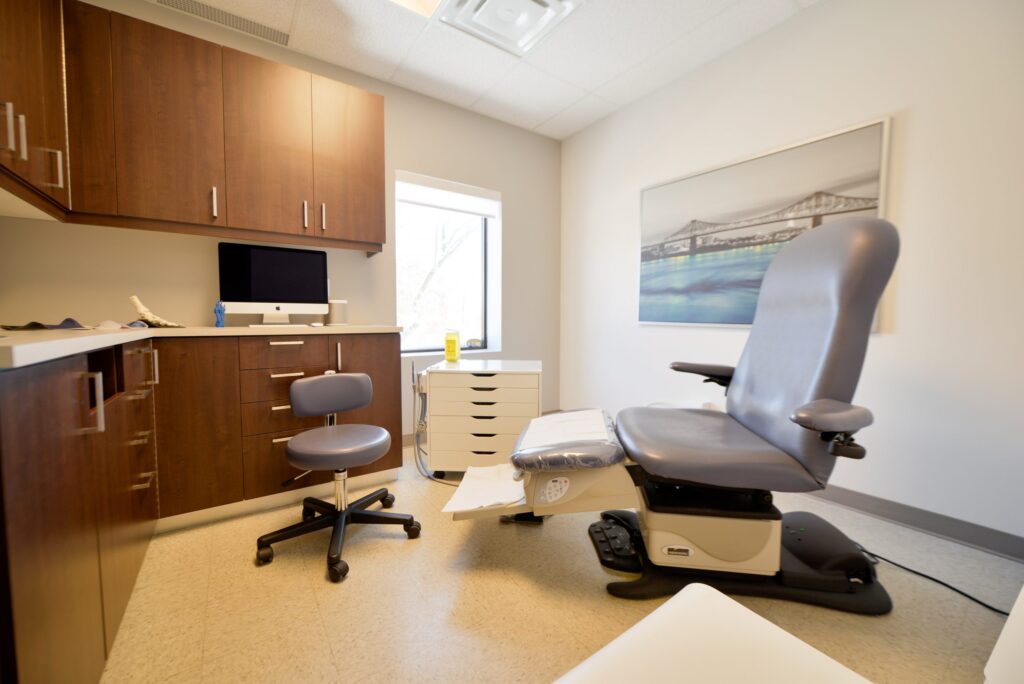
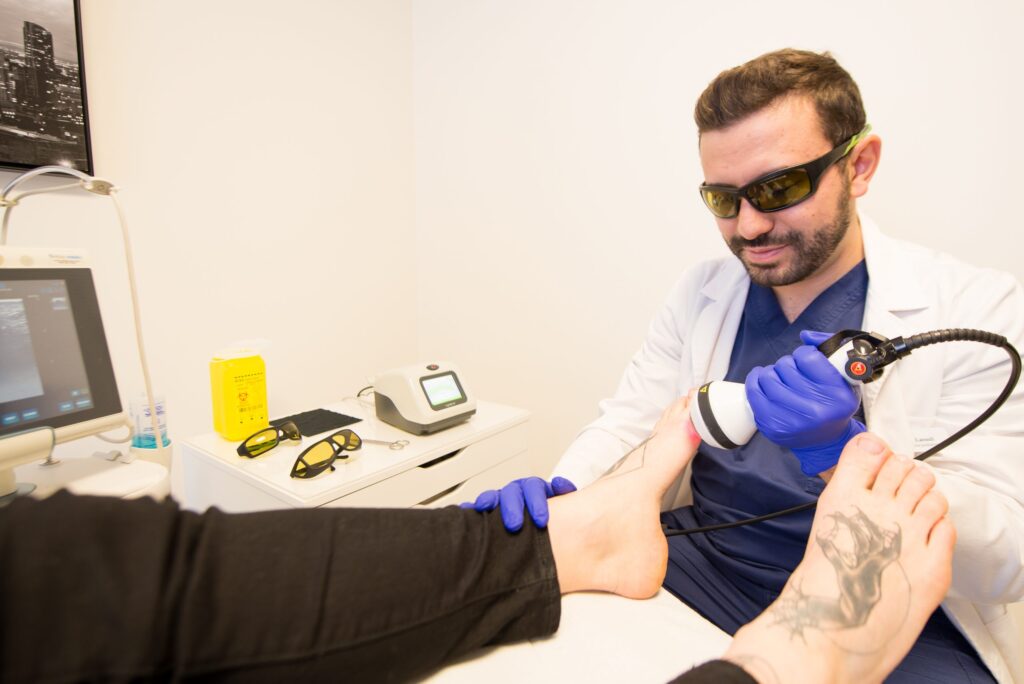
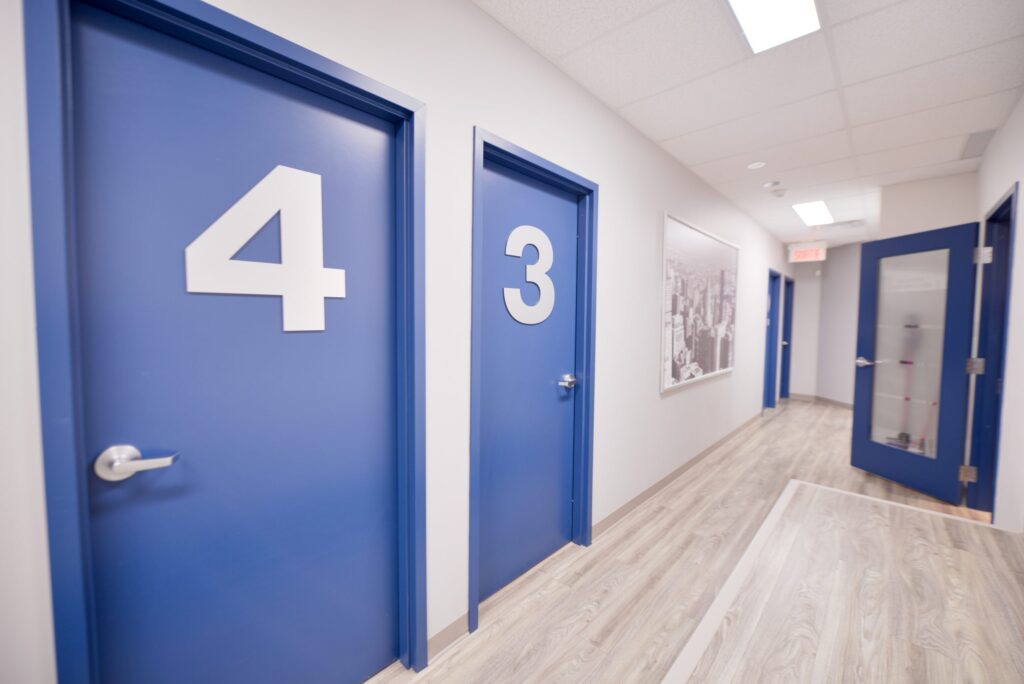
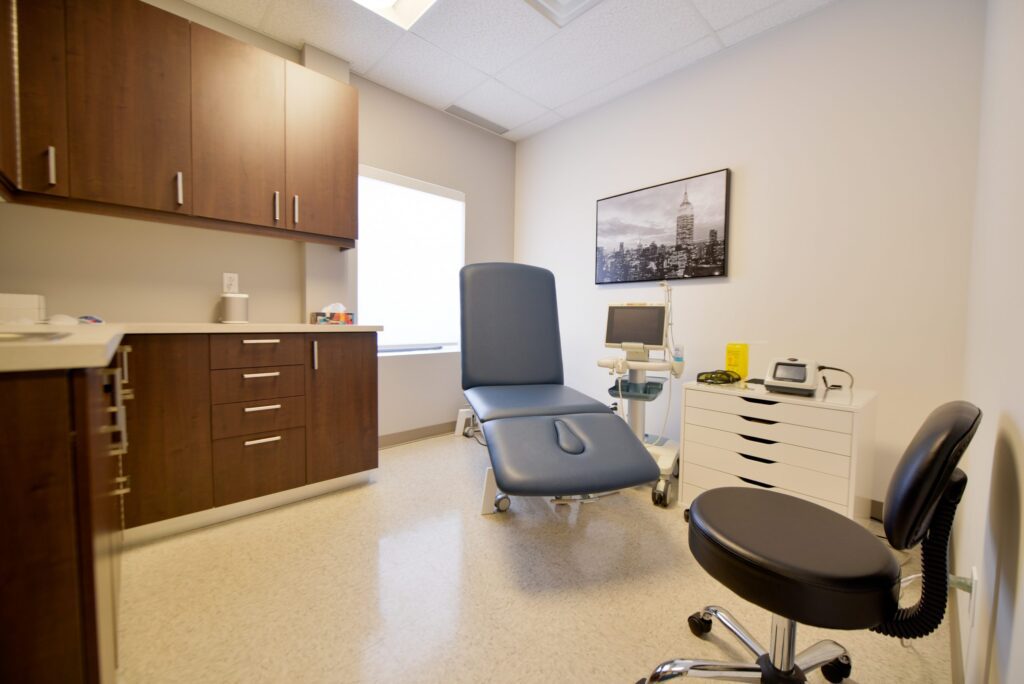
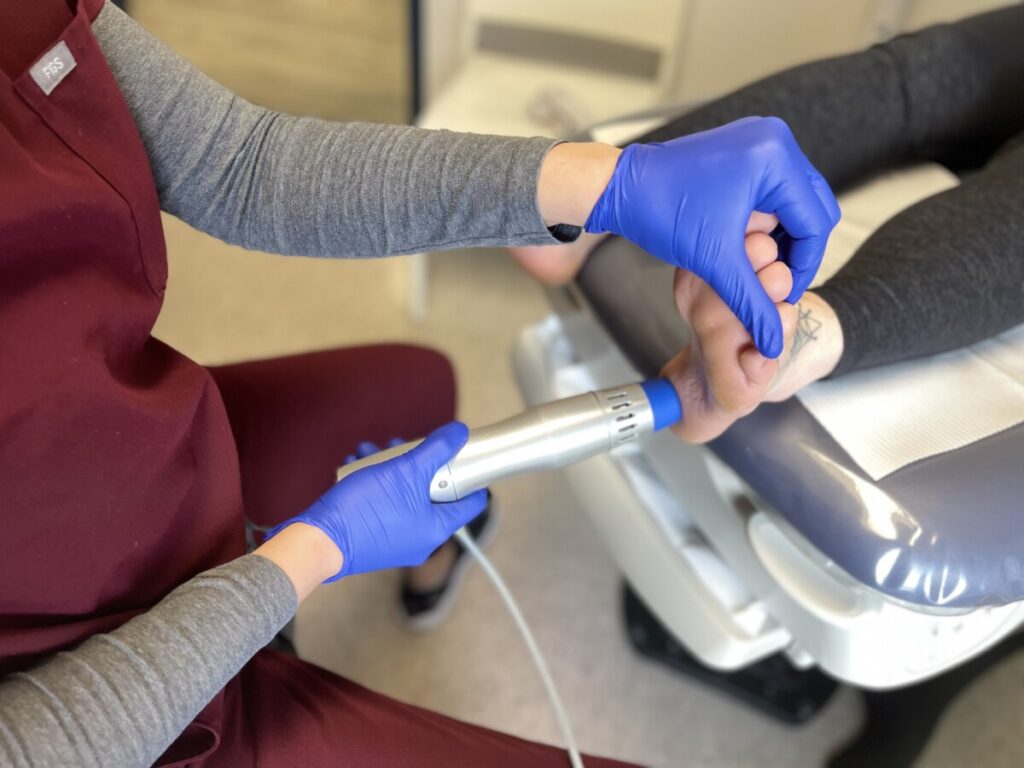
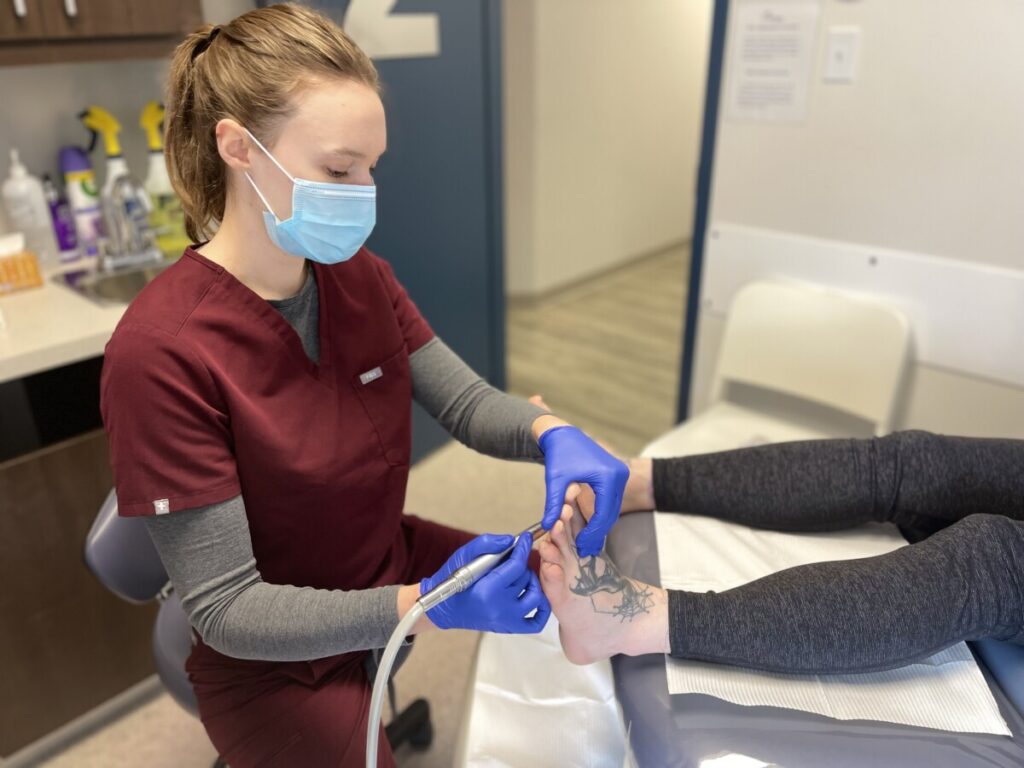
Frequent problems
Sud-Ouest podiatry clinic : pain : foot, ankle, leg, knee, hip and lower back
Did you know that this type of pain is often related to unbalanced feet and legs?
Foot pain is very common, and often localized in the heel. The most common heel pain is plantar fasciitis. The forefoot is also often a source of pain. This pain is usually located on the soles of the feet just behind the toes. The term “metatarsalgia” encompasses the majority of these pains, which can then be more specifically classified according to the area affected and the source of pain or discomfort. Morton’s neuroma, hallux abducto valgus (foot bunion) and hammer toes are some of the most common disorders of the forefoot. The condition that affects the top and central portion of the foot often results from osteoarthritis. This osteoarthritis is normally the wearing down of the joints caused by a misalignment of the foot.
Ankle pain can be caused by an old injury such as an improperly healed sprain or fracture and/or a functional foot problem. The onset of...
Sud-Ouest podiatry clinic : ingrown toenail (onychocryptosis)
Ingrown toenails are a frequent nail issue that can be extremely painful and even incapacitating. It's identified by a toenail that grows into the flesh and punctures it.
Ingrown toenails cause irritation and, in the worst-case scenario, infection, resulting in painful toes.
As a result, it is critical to address the problem as soon as possible in order to prevent the situation from spiralling out of control.
Let's look at the causes, symptoms, and remedies for ingrown toenails.
An ingrown toenail can be identified by a variety of symptoms. Inflammatory redness, pain when squeezed, and, in some circumstances, blood or pus on the side of your nail are all possible symptoms.
However, keep in mind that an ingrown toenail has three stages;
- First stage: there is a small inflammation and pain when pressed.
- Second stage: we observe an infection and the wound becomes more visible.
- Third stage:...
Sud-Ouest podiatry clinic : plantar warts: causes, symptoms and treatment
A viral infection is what causes a plantar wart, which is a skin lesion. It can either stay dormant for years or develop and spread quickly. It's a contagious skin condition that affects you and those around you.
The HPV, or human papillomavirus, creates these lesions. Despite the fact that it is a harmless virus, it is recommended that you get treatment as soon as possible to get rid of it.
The plantar wart frequently appears as a tiny, rough, spherical, and flat lump. It will manifest itself in a variety of ways.
- Appearance: it consists of spongy, brownish or yellowish tissue with small black dots;
- Size: it can measure from a few millimeters to several centimeters in diameter;
- Pain: plantar warts can be painful, even though they are uncommon. Friction or a pressure point can produce this type of pain, which can become severe;
- Posture problem: the foot pain caused by the plantar wart can lead to a foot positioning...
Sud-Ouest podiatry clinic : plantar fasciitis: causes, symptoms and treatments
Plantar fasciitis is a common foot condition. A strain or break in the plantar fascia, the fibrous band that supports the arch of the foot, is at the root of this condition.
Heel discomfort is the most prominent sign of this condition. It will be felt from the first steps in the morning or after a lengthy period of sitting.
You can find plantar fasciitis symptoms, causes, and remedies are listed below.
A person with plantar fasciitis will feel discomfort when they first walk in the morning, but it will subside over the day. They will also experience discomfort after sitting for an extended period of time.
Plantar fasciitis can also cause the following symptoms:
- Pain when palpating your arch or when pressing on your heel;
- Standing or walking causes pain, which might worsen over time;
- Tension on the outside of the foot, which can cause compensating foot and leg discomfort;
- A condition...
Sud-Ouest podiatry clinic : metatarsalgia : symptoms and treatments
Do you ever get a pain in the foot that makes you feel like you have needles or pebbles in your shoes? If so, you may have metatarsalgia.
This is what we call the pain in the area of the foot sole, between the arch of the foot and the toes. If you have metatarsalgia, you may experience pain in a very localized area or on your entire forefoot.
Metatarsalgia is basically caused by inflammation. Often, the patient who suffers will feel that their socks are always bunched up at the base of the toes. Sometimes they will even feel like they are walking with a pebble or needles in their shoe.
- Burning sensation at the front of the foot
- Swelling of the front part of the foot
- Swelling on the front and top of feet
- Calluses on the front part of the feet
- Difficulty crouching down on bent toes
- Twinge in the foot...
Sud-Ouest podiatry clinic : heel spur (lenoir’s thorn)
When you place your foot on the ground, do you feel discomfort beneath your heel?
Seeing as calcification under the calcaneus is quite common, Lenoir's thorn might be the disease that affects you.
The heel spur, known as Lenoir's thorn, is a bony protrusion on the inside of your heel. This anatomical structure can be seen by X-ray.
People with this condition frequently experience pain in their heels while taking their first steps in the morning or after sitting for a long period. They may also notice a painful spot in their heel, such as a spur.
Imaging is usually used to detect this structure. It is very difficult to feel by touch.
Let's take a look at what makes heel spurs develop, as well as the therapies that can help you get rid of the discomfort they produce.
Heel spurs usually do not cause any symptoms.
When walking or standing for lengthy periods of time, the majority of persons with this...
Sud-Ouest podiatry clinic : foot bunion (hallux valgus)
Is it difficult to walk on your foot because of a deformity in the big toe area? Is your big toe extending from the base due to the same deformity? Do you have pain and inflammation in your joints?
If this is the case, consult a podiatrist right away because you most likely have a bunion (hallux valgus).
Don't be deceived if the bunion appears to be painless at first.
Hallux valgus can produce a variety of unpleasant symptoms, ranging from minor aches and pains to ingrown toenails and mobility issues.
Here's a rundown of the signs and symptoms of a bunion:
- The appearance of a hump at the base of the big toe caused by a common joint displacement
- Beginning of the displacement of the big toe towards the 2nd toe
- Appearance of joint stiffness and pain when moving straight
- Having trouble putting on shoes (widening of the forefoot)
- Second toe deforms and becomes clawed or...
Sud-Ouest podiatry clinic : flatfoot : symptoms and treatments
Is there little or no curve in your foot arch? Do you get foot or joint discomfort when you stand? Flatfoot might be to blame for these problems.
Flatfoot is the collapse of the arch of the foot, as the term implies. Flatfoot is most visible when standing or walking, and it can cause serious postural issues. Fortunately, there are treatment options for treating this condition.
Flat-footed people may feel localized pain in the plantar area. However, this disease can have postural, musculoskeletal, or articular consequences.
The following are some of the most frequent symptoms of flat feet:
- Pain in the arch of the foot
- Joint pain in the ankles
- Change in the shape of the foot
- Feeling of imbalance on uneven ground
- Inward tilting of the heel and knees
- Ducking" gait
- Knee pain
- Lower back pain in the lumbar region
If flatfoot is not...
Sud-Ouest podiatry clinic : cavus foot : symptoms and treatments
Unlike the flat foot, which is intended to be supple and flattened, cavus foot is excessively arched and rigid. This foot problem is characterized by a pronounced curvature from the top of the secondary foot to the plantar arch that is very high.
It is also possible to observe a tightening between the heel and forefoot. This results in a curled appearance of the affected feet.
Cavus foot is not always a major source of pain as soon as it appears. However, if the deformity increases and the foot becomes more rigid, the arched foot can cause serious discomfort.
Initially not very burdensome, advanced stage cavus foot can compromise the quality of life of individuals suffering from it.
In addition to causing pain in the plantar arch, hollow foot usually leads to the following symptoms:
- Plantar arch curvature more pronounced than normal
- Hump on the top of the foot corresponding to the...
Sud-Ouest podiatry clinic : achilles tendinitis : symptoms and treatments
Overuse of the tendon that links the calf muscle to the heel can lead to Achilles tendinitis. As a result, Achilles tendinopathy is a frequent issue among runners. This disease causes discomfort that rises at the start of activity and diminishes afterwards.
Are you an athlete who regularly gets discomfort in the rear of the ankle when training? Do you have muscular stiffness that lasts throughout the day when you get up? Have you seen a suspicious lump on the rear of your Achilles tendon recently?
You almost certainly have Achilles tendinitis if you experience the aforementioned.
The Achilles tendon, also known as the calcaneal tendon, is one of the largest and most active tendons in the human body. When it gets inflamed, it affects the entire body. Achilles tendinitis can take two forms: the acute form and the chronic form.
The following are the most common symptoms seen in people with acute Achilles tendinitis:
- A...
Sud-Ouest podiatry clinic : morton’s neuroma : symptoms and treatments
Do you suffer from foot pain that resembles electric shocks in the forefoot, followed by numbness in your toes? If you experience this, it can be symptoms caused by neuroma, also known as Morton’s neuroma.
This problem is due to a thickening of the nerves located between the toes, as a result of compression or friction. This leads to inflammation, numbness, burning or a sensation of small electrical discharges felt in the toes.
Although there is no outward sign of this condition, neuroma triggers several uncomfortable sensations in different areas of the foot.
- Numbness and tingling in your toes
- Sensation of burning in the forefoot
- Sensation of having a bunched up sock under your toes
- Sensation of small electrical shocks in your toes
- Toe cramps
These symptoms are aggravated if you remain standing for long periods of time or if you wear narrow shoes that are not...
Sud-Ouest podiatry clinic : athlete’s foot (tinea pedis)
Trichophyton fungi are what causes an athlete's foot - a dermatological infection. This foot fungus thrives in the spaces between the toes, where moisture tends to build up.
The fungus that causes athlete's foot is very infectious and may be found in locations like locker rooms and public swimming pools.
Athlete's foot is a difficult condition to treat, and it frequently recurs. If left untreated, it can extend to the sole of the foot, resulting in bacterial infection and problems.
It can spread to the nails in advanced stages, causing them to stiffen and discolor. Athlete's foot can also produce discomfort in other parts of the body, such as the groin or hands.
Let's look at how to spot this problem and what you can do to avoid it.
Athlete's foot is a skin infection that mostly affects the toes. Tinea pedis symptoms are generally more unpleasant than painful, but they should never be overlooked.
An athlete's foot...
Sud-Ouest podiatry clinic : big toe osteoarthritis (hallux rigidus)
Osteoarthritis of the big toe is a degenerative condition that causes joint hardening and a progressive loss of mobility, which may be quite painful.
The most prevalent type of joint deterioration is osteoarthritis. The metatarsophalangeal joint of the big toe is affected by hallux rigidus.
If the big toe osteoarthritis is not treated, the front of the foot loses mobility and eventually freezes.
This disease can cause discomfort and deformity, making it difficult to wear shoes.
Osteoarthritis of the big toe, like many foot diseases, is simpler to treat if caught early.
Learn about the warning symptoms of hallux rigidus and how to avoid it by developing good habits.
The consequences of a hallux rigidus issue might be so severe that surgery is required.
This is why it's critical to recognize the signs and symptoms of big toe osteoarthritis.
The presence of hallux rigidus may be indicated by the...
Sud-Ouest podiatry clinic : sesamoiditis : symptoms and treatments
The inflammation of the sesamoid bones under the metatarsal head near the big toe is known as sesamoiditis.
This plantar condition, which is more frequent among dancers and runners, produces discomfort and limits movement flexibility.
Although sesamoiditis is relatively simple to cure on its own, it is critical to detect the warning symptoms before it worsens.
Here are the symptoms, causes and medical treatments for sesamoiditis in the foot.
The sesamoids are interesting little bones that aren't formally part of the human skeleton. They aren't related to anything else in the musculoskeletal system save a tendon and a joint.
Despite their small size, they can cause physical and mechanical pain.
In sesamoiditis, they are the cause of symptoms like:
- Swelling of the affected area
- Pain under the base of the big toe that gets worse when walking
- Redness or bruising of the...
Sud-Ouest podiatry clinic : foot arthritis : symptoms and treatments
Whether due to premature joint degeneration or a disease of the immune system, foot arthritis is a very uncomfortable condition.
Arthritis is usually characterized by musculoskeletal pain accompanied by day-to-day difficulties in mobility.
Joints like knees, hips and ankles are particularly vulnerable to this condition.
Currently, there is no single medical solution that completely cures foot arthritis.
However, by acting from the onset of the first symptoms, it is possible to reduce the impact of the ensuing complications.
Let’s examine what causes this degenerative disorder and how to effectively relieve it.
When arthritis affects the feet, it generally takes two forms: rheumatoid arthritis and osteoarthritis.
Rheumatoid arthritis is an inflammatory condition caused by an autoimmune disease where heredity can be an aggravating factor.
This form of arthritis affects people...
Sud-Ouest podiatry clinic : functional hallux limitus
Normally, the big toe has a limited range of motion. However, a joint obstruction can occasionally induce knee discomfort, heel pain, and ankle sprains.
This is known as hallux limitus.
Without therapy, functional hallux limitus can progress to hallux rigidus, a potentially crippling type of big toe osteoarthritis.
Learn about the symptoms, causes, and treatments for functional hallux limitus before permanent harm occurs.
One of the risks of hallux limitus is that it is difficult to identify in its early stages.
Because it affects the big toe, it is likely to have symptoms comparable to other diseases.
In order to obtain treatment as soon as possible, you should identify the following symptoms:
- The buildup of corns and calluses on the inner side of the big toe
- Significant discomfort in the big toe and surrounding area
- Pain in the knees
- Tension in the sole of...
Sud-Ouest podiatry clinic : toenail trauma : symptoms and treatments
Toenail trauma can result from a variety of causes, including a blow, a crush, or a foreign body.
Even if toenail trauma is benign in the majority of cases, there is always the danger of lifelong abnormalities.
It is advised that toenail trauma be treated as soon as possible to reduce the cosmetic hazards connected with it.
Given how similar this sort of damage can be to a tumor under the toenail, it should be given considerably more attention.
Toenail trauma is the nail's reaction to an unusual shock or force, as the term indicates.
The following symptoms appear after an accident that causes a subungual hematoma:
- A buildup of blood in the shock-affected nail tissue
- A change in the color of the nail to dark purple or blackish blue
- Pain that lasts for a long time or throbs
- Partial or total nail detachment in the weeks following the traumatic incident
Other...
Sud-Ouest podiatry clinic : joint wear and tear : symptoms and treatments
Joint wear and tear is commonly associated with aging, although it can also be caused by other factors.
Joint degeneration is a complex process that can be impacted by a mix of reasons.
However, when it comes to joint damage, a small set of pathologies account for the vast majority of instances recorded.
Let's take a look at the most common causes of early joint wear and strain, as well as how they appear in daily life.
Osteoarthritis, the most prevalent kind of arthritis, affects the whole joint, beginning with the deterioration of the cartilage that protects the bones.
The fluidity of bone contacts gradually decreases to the point that movement flexibility is hampered.
Osteoarthritis produces symptoms that come and go at first. These symptoms do not persist till much later.
The following are some of the symptoms of osteoarthritis:
- Knees, hips, ankles, and foot joint...
Sud-Ouest podiatry clinic : heel bursitis : symptoms and treatments
Heel bursitis (also known as calcaneal bursitis) is a painful disease that can make daily activities difficult. This foot condition arises when a bursa, a sac that secretes synovial fluid and serves to lubricate the joint between the bone and the tendon, becomes inflamed.
Although heel bursitis is usually harmless, it is nonetheless painful and uncomfortable. If you believe you have it, you should get assistance as soon as possible. You'll be back on your feet in no time with the correct intervention at the right moment!
However, some people, particularly athletes, continue to participate in sports despite chronic bursitis. This might aggravate the bursitis, producing extra foot discomfort and worsening the inflammation.
PiedReseau explains the many methods for detecting, treating, and avoiding this condition.
To determine when to see a podiatrist, you must first understand the most common symptoms of bursitis. Keep a close eye on the...
Sud-Ouest podiatry clinic : foot capsulitis : symptoms and treatments
Foot capsulitis is a type of metatarsalgia in which the joint capsule of the metatarsal bones is inflamed.
Although it is more prevalent in the shoulder, knee, or elbow, it is probable that it might also happen in the foot.
Let's look at what causes foot capsulitis, how to cure it, and what symptoms it triggers.
While we are all too familiar with the problems that capsulitis in the shoulder may cause, its plantar equivalent can be just as bad.
The following symptoms are commonly associated with capsulitis in the foot:
- A burning sensation under the toes in the front area of the foot;
- Numbness in the forefoot;
- A feeling of a lump under the forefoot;
- Putting weight on the front half of the foot becomes difficult;
- Pain in the phalanges (toes);
The symptoms indicated above should be closely monitored since if not addressed promptly, they can lead to serious...
Sud-Ouest podiatry clinic : plantar fibromatosis
Plantar fibromatosis is a thickening of the aponeurosis tissue in the arch of the foot.
Plantar fibromatosis often manifests as tiny lumps.
Although it is typically harmless, it can cause pain when walking and can make it difficult to move.
It's critical to understand the signs in order to detect it before it becomes a serious issue.
The following are the symptoms and treatments for plantar fibromatosis.
Plantar fibromatosis, which mostly affects the arch of the foot, is considered benign until proven otherwise.
It is commonly linked to the following symptoms:
- A hard growth in the arch of the foot that may stay the same size or expand
- Other protrusions identical to the first one forming beneath the foot
- Walking pain might occur in various circumstances (with or without shoes)
Fibrosis, while not extremely limiting, can lead to a multitude of problems if...
Sud-Ouest podiatry clinic : heel (calcaneus) fracture
The calcaneus, or heel bone, accounts for only 1 to 2 percent of all fractures. A heel fracture, unlike other common injuries, can have serious implications if left untreated.
The calcaneus is the bone that forms the rear of the foot, together with the talus. These two bones sustain the body's weight when they are joined together.
The calcaneus is also the bone that is closest to the ground. As a result, it's not unexpected that this bone, which is only a few centimetres long, can sustain a tremendous amount of weight.
The location of the calcaneus, on the other hand, makes it extremely susceptible in the event of a rapid and strong impact.
The heel fracture is particularly difficult to diagnose due to its rarity. This is incompatible with the severity of long-term consequences like osteoarthritis.
It's critical to understand how to detect a heel fracture so that you can treat it promptly.
On the surface, a heel...
Sud-Ouest podiatry clinic : cuboid bone subluxation
When the foot is exposed to a succession of microtraumas or a sudden severe shock, it results in subluxation, or the cuboid syndrome.
Many sportsmen and dancers suffer from cuboid subluxation because of the circumstances in which it develops.
Because the symptoms of cuboid syndrome can be quite similar to those of other plantar diseases, it's crucial to understand the differences.
Let's look at what causes whole or partial dislocation of this bone portion of the foot, as well as how to cure it.
The foot is an anatomically complex structure.
So, before we go into the specific reasons for cuboid syndrome, it's helpful to understand what to expect when it's subluxated.
The foot is normally split into two sections: the forefoot and the rearfoot.
The phalanges, the 14 tiny bones that make up the toes, articulate the forefoot.
The tarsus is made up of seven bones that make up the...
Sud-Ouest podiatry clinic : knock-knees (genu valgum)
Genu valgum, commonly known as knock-knees, are generally present from childhood.
The varum knee, unlike the valgus knee, shows in youngsters as a cowboy-like outward deviation of the joint.
The valgus knee, on the other hand, produces inward movement of the knees.
If left untreated, this condition makes it difficult to move the legs and feet. It can eventually damage the joint cartilage, resulting in knee osteoarthritis.
This is why detecting symptoms and implementing a customized treatment plan are critical for this condition.
Valgus knee is seen as a juvenile physiological abnormality.
At birth, most infants will have some outward deviation of the lower limbs.
Later on, this deviation will tend to be reversed in the first years of life. Genu valgum is the medical term for this condition.
However, if the axial deformity of the lower limbs continues throughout maturity, it becomes more...
Sud-Ouest podiatry clinic : tarsal tunnel syndrome
A painful compression of the tibial nerve is what characterizes a tarsal tunnel syndrome.
The tibial nerve extends from the back of the calf to the heel and sole of the foot and is encased in the tarsal tunnel, a fibrous canal.
When the tissues around this canal become inflamed, they might expand and compress it, causing the tarsal tunnel syndrome pain.
Let's take a look at the signs and symptoms of this foot problem, as well as the remedies available.
It is critical to understand the symptoms of tarsal tunnel syndrome in order to get treatment as soon as possible.
The following symptoms are caused by tibial nerve neuralgia:
- Weight bearing and wearing particular shoes exacerbate pain on the inside of the ankle;
- Discomfort that fades with rest;
- A tingling or burning feeling beneath the foot, particularly when walking;
- An increase in the stiffness of the foot...
Sud-Ouest podiatry clinic : patellofemoral syndrome
Also known as runner’s knee, patellofemoral syndrome is a condition resulting from a malfunction of the internal structures of the knee and femur.
This pathology is common among athletes and is even more painful when the kneecap is subjected to repeated stress.
If left untreated, patellofemoral syndrome can cause premature wear and tear of the cartilage and may result in irreversible damage.
Let’s look at its characteristics, what triggers its appearance and how to prevent it.
A kneecap condition like patellofemoral syndrome triggers symptoms that may be similar to those of other conditions.
That’s why it is so important to be able to distinguish them correctly.
Usually, patellofemoral syndrome manifests itself by these symptoms:
- Dull pain in the front of the knee, which can extend deep into the kneecap
- Discomfort that occurs during physical activity and persists...
Sud-Ouest podiatry clinic : foot deformities : symptoms and treatments
Even healthy feet are susceptible to trauma and the accompanying damage. What about foot deformities, though?
In fact, under the required circumstances, any foot can develop a deformity. Let's take a look at some of the disorders that might cause misshapen feet, as well as some of the treatment options available.
It is vital to distinguish the many types of foot deformities before describing the symptoms that can overwhelm a patient with plantar abnormalities.
There are seven different types of plantar abnormalities that can affect adults:
- The flat foot: The flat foot has a sagging arch, unlike the usual, healthy foot. Almost everyone has this type of foot during early childhood.
- The cavus foot: A so-called "hollow" foot is characterized by an arch that is too pronounced. Although it is regularly associated with genetic factors, hollow foot is also found in athletes or in association with neurological...
Sud-Ouest podiatry clinic : lower back pain (lumbago)
Lower back pain (also known as lumbago) is becoming increasingly common. According to the National Institute of Neurological Disorders and Strokes (NIH), roughly 4 out of 5 people will suffer low back pain at some point in their lives. It is also one of the world's major causes of stopping work.
Low back discomfort affects your lumbar vertebrae, as the name implies. There are 5 in total, and the lumbar is beneath your ribs, near the bottom of your spine. This sort of discomfort can also impact the sacrum, which links your tailbone to your spine.
The pain may spread to your buttocks, thighs, knees, legs, and feet in certain situations. The fact that we are bipedal, among other factors, helps explain this sort of discomfort. In reality, our spines were intended for four-legged creatures, but evolution has led to back issues.
Although lower back discomfort generally goes away on its own, podiatric therapy may be required to resolve this issue, which can...
Sud-Ouest podiatry clinic : hammer toe : symptoms and treatments
Do you ever feel pain in your toes? Are you afraid the contracture will get progressively worse? If you answered yes, you may be suffering from hammer toe.
Hammer toes, claw toe or mallet toe are characterized by a contracture of the toe. The curvature of the affected toes gives the impression that your toes take the shape of an inverted V or hook. However, it is a problem that can be corrected.
A very large number of men and women suffer from hammer toes. This deformation of the toes can be divided into 3 categories. In addition to hammer toes, we find claw toe and mallet toe.
- Hammer toes: of the three occurrences, this is usually the most problematic contracture. The top of the toe’s joint is pushed upwards and rubs against the top of the shoe, causing pain. Wearing shoes then becomes increasingly uncomfortable and walking is very painful. A podiatrist can help you correct the problem with small silicone orthoses designed for your toes....
Treatments provided
Sud-Ouest podiatry clinic : plantar orthotics: types, benefits, and adaptation tips
The primary goal of plantar orthotics is to improve the function of your foot in order to correct various biomechanical flaws or posture issues. They are used to compensate for certain deficiencies in your foot. Because they are custom designed specifically for your condition, the orthosis is perfectly adapted to the shape of your foot to optimize its function.
In addition to relieving any pain you may experience, a custom-made foot orthosis is adapted to the morphology of your feet, and redistributes the pressure exerted on them. It can therefore be used to treat many pathologies and deformities. Remember that the health of your feet is important to be able to perform your daily activities.
To ensure your orthotics treatment provides effective results, the podiatrist will have to evaluate you and design a custom casting of your feet. You will be cared for during all stages of the process, to ensure you receive the correct orthosis, which you can...
Sud-Ouest podiatry clinic : cortisone injections
Cortisone injections, sometimes referred to as “cortisone infiltration,” are often a beneficial podiatry treatment used to relieve acute or chronic pain related to various musculoskeletal issues. Actually, cortisone is a hormone frequently used as an anti-inflammatory to relieve certain joint pains, rashes, inflammation or swelling.
Learn more about cortisone injections, an effective treatment with numerous benefits, but which must generally be used in the short term, with care and discernment, by a healthcare professional.
Sud-Ouest podiatry clinic : ingrown toenail treatment by a podiatrist
An ingrown toenail (onychocryptosis) is an inflammation caused by a portion of a nail (usually on the big toe) penetrating the surrounding skin.
While usually minor, it is nonetheless a common nail problem that can result in pain and inconvenience in your daily life. If the ingrown toenail is not treated, it may lead to inflammation and exacerbate the pain in the foot.
Do not worry, however, as there are a variety of useful therapies available to help you get rid of ingrown toenails and get your feet back on track. Learn more in this article.
Medical nail clipping is one of the most traditional nail care procedures. Nail clipping is a common solution for ingrown toenail problems that is performed by a podiatrist or a specialized nurse (assistant). Professionals in the field of foot care can customize a cut to your nail's condition.
Nail care, on the other hand, is more than simple nail trimming, as antibiotic creams or baths can...
Sud-Ouest podiatry clinic : a podiatrist’s treatment for plantar warts
Plantar warts are common skin lesions that can be quite unsightly. They are often harmless, although they can be infectious and unpleasant.
In reality, these growths on the foot might cause bleeding or create other issues such as irritation, pain, or infectious cellulitis in the long run.
Furthermore, if you are diabetic, elderly, or immunosuppressed, your plantar warts are more likely to cause problems.
Fortunately, plantar warts may be treated in a variety of ways to reduce the risk of infection and consequences. Let's have a look at those.
Your podiatrist can write you a prescription for painless wart treatment at home. The majority of these medicines are used topically.
Prescription medication care can:
- Treat plantar warts at home;
- Treat plantar warts completely painlessly.
However, this type of treatment...
- Is usually longer lasting;
- Must be...
Sud-Ouest podiatry clinic : foot care – nails, corns and calluses treatment
Performed by a podiatrist, foot care includes many treatments and assessments aimed at preventing pain, reducing restrictions and promoting comfort. They can even be performed at home by a specialized caregiver.
A versatile professional, the podiatrist uses a variety of treatments to the benefit of your feet:
- Physical treatments;
- Pharmacological treatments;
- Orthopedic treatments;
- Surgical treatments.
A number of cases require foot care to be performed in a professional clinic. Therefore, the podiatrist and their team can provide you with a complete service to prevent and treat your foot pathologies. Naturally, all of this is done with clean, sterilized equipment.
Read on to learn more about the different treatment options.
Among the common foot treatments performed in podiatry you can find:
- The application of special creams;
- The prescription of...
Sud-Ouest podiatry clinic : evaluating children’s feet
Having your children’s feet evaluated by a competent foot care professional will ensure proper management of any foot pathology that may worsen over the years.
Thus, when taken care of early enough, it is possible to improve your child’s postural development by evaluating and correct any foot issues for the rest of their lives!
Sud-Ouest podiatry clinic : biomechanical exam : symptoms and treatments
Comprehensive biomechanical examinations are carried out in a podiatric clinic in order to make an accurate diagnosis of your condition. It is thus possible to establish the best possible treatment plan. During your visit, podiatric doctors who provide advanced expertise will evaluate you.
A complete examination done in a podiatric clinic includes:
Sud-Ouest podiatry clinic : foot ultrasound imaging
A musculo-skeletal ultrasound of the foot is a medical imaging technique used to examine pathologies that affect soft tissues such as ligaments, tendons, nerves and muscles. Complementary to the clinical examination, a foot ultrasound provides an accurate diagnosis and is used to design a more structured treatment plan for patients.
A foot ultrasound is an imaging technique that does not use radiation, and is completely safe. Children, adults and seniors can all benefit from this service, regardless of their physical condition.
Easily administered, a foot ultrasound provides results almost equivalent to those of an MRI, ensuring rapid diagnosis and management of the condition.
Sud-Ouest podiatry clinic : ultrasound guided injection
Ultrasound-guided injection can be used to deliver treatment directly to the affected area.
It may contain an anti-inflammatory solution, similar to the cortisone injection in the foot.
Ultrasound-guided injections, however, are more typically utilized to guide a medical practitioner during surgery on minor foot structures.
This type of infiltration not only relieves pain in pathologies including osteoarthritis of the big toe, plantar fasciitis, Morton's neuroma, and other plantar ailments, but it also allows for viscosupplementation and hyaluronic acid injection into particular joints.
This treatment offers pain alleviation that is both effective and safe.
Discover what makes this modern process unique, as well as how it can be beneficial for you.
Podiatrists can work safely and efficiently with ultrasound injection.
Although such a guiding device is occasionally required for cortisone injection in the...
Sud-Ouest podiatry clinic : therapeutic laser treatment
Minimally invasive and highly effective, the therapeutic laser is a modern treatment for foot pain.
The laser treatment performed in the clinic relies on technology that thoroughly heals the damaged tissue through photobiomodulation.
This method accelerates the body's natural healing process, similarly to ShockWave therapy.
The therapeutic laser treatment provides relief from chronic pain, acute pain as well as post-surgery complaints.
This treatment uses safe beams of light, also known as high-power laser therapy.
When these light beams hit the skin, they penetrate the structures at the surface. Adding slight pressure may also allow the laser to reach deeper into the affected tissues.
Once they have penetrated the epidermis, the beams of radiation that reach the tissue are absorbed by melanin and hemoglobin.
As a result, the patient feels almost immediate relief when this energetic phenomenon is then...
Sud-Ouest podiatry clinic : shockwave therapy : therapeutic benefits and treatment
ShockWave therapy was first used to break up kidney stones.
This therapeutic technology, however, has been adapted to other medicinal purposes as well. Nowadays, podiatrists use it in the clinic to treat difficult-to-repair musculoskeletal injuries.Acoustic waves are at the core of the ShockWave therapy. Through a sequence of high-speed shocks, it strengthens the body and aids in the recovery of painful foot disorders. Most notably, it is used to treat plantar fasciitis, Achilles tendinitis, and heel spur.
In the case of ShockWave therapy, the podiatrist treats plantar conditions with a special device that includes an applicator.
When the applicator emits a high-intensity pulse, it is transmitted through the skin to the tissue that requires treatment.
By inducing microtrauma around the affected region, this technique aims to cause an inflammatory response in the body.
While it may appear counterproductive, it is a powerful...
Sud-Ouest podiatry clinic : nail culture : importance, advantages and procedure
Nail culture consists of taking nail and skin fragments from under a nail that appears to be affected by a fungus.
The main purpose of this procedure is to rule out a diagnosis of various pathologies comparable to fungal toenail disease.
Examples include eczema or psoriasis, which may have similar symptoms but do not require the same treatment as onychomycosis.
Minimally invasive, nail culture has many benefits.
One of these is to facilitate the detection of a fungal foot infection that is difficult to treat if not treated early.
Learn how nail culture fits into the podiatrist's arsenal of diagnostic tools and how it can help in selecting the right treatment for you.
Some symptoms of nail fungus are similar to other skin infections such as psoriasis and eczema when left untreated.
The following symptoms are similar to those of nail fungus and are sometimes observed in patients with...
Sud-Ouest podiatry clinic : therapeutic foot taping
Therapeutic taping consists of adhesive bandage that is strategically applied to specific areas in order to increase muscle tone or reduce pain associated with certain movements. Contrary to popular belief, therapeutic taping helps more than just for athletes.
While its use is widespread among runners and tennis players, therapeutic taping is also suitable for the general population. It is efficient for relieving very specific joint and muscle pain, however therapeutic taping cannot be applied just anywhere at random.
That's why it's important to trust a qualified professional such as a podiatrist to perform the taping. If you have been struggling with muscle pain or tension for some time, therapeutic taping may be right for you.
Taping is often used in addition to physiotherapy and plays a therapeutic role for many people.
This comes in 3 types: athletic taping, neuro-proprioceptive taping and finally therapeutic or compressive...
Sud-Ouest podiatry clinic : 2d and 3d digital imaging
Foot digitization consists of capturing the imprint of the feet using various devices to establish an accurate diagnosis. This technique is particularly useful when it comes to designing custom-made plantar orthotics.
2D impressions are taken using a podograph. A kind of pressure-sensitive cushion, a scan or a mirror, the podograph detects and shows a perfect image of the foot's plantar surface.
On the other hand, the 3D scanning method requires the contribution of a three-dimensional sensor. It can accurately reproduce the entire morphology of the foot.
These scanning methods make it possible to conceptualize the foot and determine the source of discomfort extremely rapidly.
For the podiatrist, taking an imprint is both a diagnostic measure and a solution for creating highly sophisticated foot orthotics.
In addition to creating high-precision orthotics, foot scanning plays a key role in understanding postural...
Sud-Ouest podiatry clinic : podopediatrics treatments
It can be difficult to distinguish between a problematic and a healthy foot in a growing child.
Early detection, on the other hand, allows the podiatrist to react more quickly before the foot takes its final shape.
As a result, the prescribed treatments can be more effective.
This article will cover some of the podopediatric treatments available for children's foot pain.
Before prescribing any treatment, the podiatrist must ensure that they have a thorough understanding of the child's pathology.
They do this by using a variety of analysis techniques, including:
- The biomechanical exam
- The postural assessment
- A digital X-ray of the feet
- Digital impressions in 2D and 3D
The podiatrist will observe the impact of the feet on the child's whole body using the aforementioned techniques.As a result, a child's evaluation allows for the detection of postural...
Sud-Ouest podiatry clinic : stress fracture in the foot
A stress fracture in the foot doesn't happen due to a single trauma, unlike a normal fracture.
Instead, it occurs in response to multiple repeated small stresses to the same bone in the foot.
While painful, this foot injury is particularly difficult to spot.
Therefore, to avoid unintentionally aggravating it, it is important to know how to recognize the symptoms and how to medically treat a stress fracture.
Read on to learn more about the stress fracture in the foot.
Predominantly found in athletes, stress fractures are usually located in the heel or midfoot.
Stress fracture in the heel: This part of the foot is instrumental in absorbing shock during stride. Therefore, it is not surprising that runners experience stress fractures in the heel.
However, the symptoms of a heel fracture can be similar to other foot problems such as:
- Talalgia
- Plantar fasciitis
- Heel...
Sud-Ouest podiatry clinic : treatment of foot pain by the podiatrist
Foot pain can appear in many ways and cause many accompanying symptoms every day.
Thanks to the high level of the podiatrist's expertise, however, you can count on treatment that is completely customized to your needs and condition. These professionals possess the latest technology to treat your pain quickly and accurately.
It is the podiatrist's duty to keep up with the latest intervention techniques to get rid of your foot pain. Thanks to their continuous training, you can be sure that your feet are in good hands.
Discover the most important treatments that podiatrists use every day to remedy foot pain.
Thanks to technological advances in the world of podiatry, patients can rely on a completely safe and effective method of treating joint, tendon or ligament problems: ultrasound-guided injection.
Unlike in the past, when injections were performed rather crudely, this type of ultrasound procedure helps the podiatrist to act...
Sud-Ouest podiatry clinic : toenail deformity : treatments
Toenails that become thick, hardened, misshapen, or even yellowed as a result of moisture or traumatic injury can affect anyone.
To help with this type of inconvenience, several treatment options are available to the patient.
If you're dealing with deformed nails, dystrophy, or onycholysis, podiatrists will help you get to the root of the issue.
Let's look into some of the treatment choices for thick, misshapen nails.
The term "toenail deformity" refers to a change in the shape of the toenails as a result of trauma or infection.
Toenail dystrophy, on the other hand, has to do with texture changes.
The deformations of the toenails are caused by a variety of factors.
We may consider, for example:
- Fungal infections, like nail fungus
- Trauma of the nail plate, by crushing or cutting
- Shock trauma to the nail matrix
- Poor healing after...
Surgical procedures offered
- Surgery for an ingrown toenail (or matricectomy)
Dr Lounes Laoudi podiatrist
Dr. Lounes Laoudi, podiatrist and owner of the Sud-Ouest podiatry clinic, has been in practice for over 5 years. Lounes Laoudi, DPM, was able to validate his competence by joining the team of Dr. Rivard, a podiatrist in Saint-Hyacinthe, before starting his own clinic.
The practitioner, who is currently based in Verdun, delivers a well-tested array of podiatric treatments that display true expertise.
A range of therapies enhanced by training
Dr. Laoudi, like his colleagues, graduated from the Université du Québec à Trois-Rivières with a Doctorate in podiatric medicine. He also had to undergo a 4-month internship at the New York College of Podiatric Medicine to solidify his expertise.
Podiatrist Dr. Laoudi also received extra training in the application of therapeutic taping in order to leave nothing to chance.
Lounes Laoudi, DPM, is a meticulous practitioner who possesses a radiology license as well as a certification in foot ultrasound.
Although he likes working with a wide range of clients, his qualifications and interest in biomechanics enable him to provide sound advice to athletes.
The podiatrist does this by employing procedures such as:
- Biomechanical exam;
- Manual foot therapy;
- Therapeutic taping;
- Therapeutic laser;
- Shockwave therapy;
- Custom-made sports foot orthoses.
A conscientious podiatrist
Dr. Laoudi, a podiatrist who is sensitive to the concerns of the underprivileged, has previously provided foot treatment at Maison Lauberivière‘s community clinic. He has also volunteered to present the workings of his podiatric specialty to physicians on a few occasions.
Dr. Lounes Laoudi is a podiatrist with an emphasis on responsiveness, who provides dependable treatments and a sharp eye.
Dr Ron Terry Bustillo podiatrist
Podiatrist Dr. Ron Terry Bustillo has obtained his Doctorate in podiatric medicine in 2018, certifying a wealth of knowledge in the field of health.
Dr. Bustillo, podiatrist uses his background as a physical therapist to enhance his podiatric treatments. He has a passion for martial arts and physical training.
His skills and experience now perfectly complement the Sud-Ouest podiatric clinic‘s team.
An impressive education
Ron Bustillo’s academic road to podiatry was paved by his significant interest in health sciences and the workings of the human body.
He studied sports science after completing his physiology degree at McGill University. He then went on to earn a master’s degree in cardiovascular physiology after that.
Dr. Bustillo, podiatrist acquired a Doctorate in podiatry at UQTR in 2014 after wanting to improve even further upon his excellent set of credentials. His hospital internships for the next four years allowed him to hone his skills, notably in the area of treating the diabetic foot.
Podiatrist Ron Bustillo now holds a radiology license as well as a foot ultrasound certificate for the foot, allowing him to:
- Perform ultrasound-guided injections;
- Perform ultrasound-guided procedures on a colleague’s patients;
- Identify the source of foot pain;
- Diagnose one pathology or rule out others.
An astute and well-informed podiatrist
Ron Bustillo’s unique perspective on biomechanics and sports podiatry was shaped by his varied work experiences.
He was a former kinesiologist who ran a gym for many years and was even the head coach of the Fédération québécoise de taekwondo.
So whether you’re an athlete, diabetic, or simply searching for a well-designed podiatric treatment, podiatrist Ron Terry Bustillo is here to help.
Dre Pauly Tang foot care auxiliary nurse
Our clinic offers a new service since summer 2019: Foot care with a nurse who works alongside a podiatrist.
Trained as a nursing assistant since 2015, Isabelle always has your best interest at heart with her expertise and good humor. A walking encyclopedia, Isabelle will be glad to chat with you about all the latest topics.
Margarita Lucas coordinator
Joining the clinic in 2016, Marie-Pier liaises with the various departments. She is responsible for coordinating the clinic’s administrative and logistical aspects, as well as providing a welcoming presence at reception. Her many years of experience allow her to answer any question you may have.
Marie-Pier Richer Laplante podiatry assistant
Currently studying sexology at UQAM, Beatrice’s empathy ensures that your visit to our clinic is defined by diligent attention. Béatrice is caring and energetic, and she is always ready to help to guarantee your best comfort.
Sophie Vachon podiatry assistant
Étant une personne articulée et au tempérament posé, c’est avec plaisir que Sophie vous accueille dès votre arrivée. Figure réconfortante à notre clinique, vous remarquerez rapidement que son approche professionnelle miroite ses années d’expérience en service à la clientèle.
Responsible for personal information/confidentiality: Lounes Laoudi 514-564-7433
Request an appointment at the clinic
Leave us your contact details and availability and we will contact you to make an appointment.












